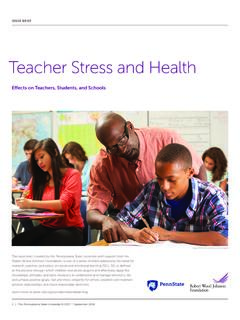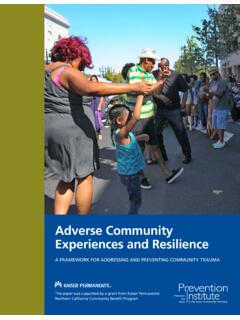Transcription of Promoting Social and Emotional Learning in the Middle …
1 Issue brief Promoting Social and Emotional Learning in the Middle and High School Years This issue brief, created by The Pennsylvania State University with support from the Robert Wood Johnson Foundation, is one of a series of briefs that addresses the need for research, practice and policy on Social and Emotional Learning (SEL). SEL is defined as the process through which children and adults acquire and effectively apply the knowledge, attitudes, and skills necessary to understand and manage emotions, set and achieve positive goals, feel and show empathy for others, establish and maintain positive relationships, and make responsible decisions. Learn more at 1 | The Pennsylvania State University 2017 | October 2017. issue brief Executive Summary Adolescence is a critical period to invest in young people's Social - Emotional competence (SEC). SEC is essential for youth to succeed in school, work, and civic life, so supporting its development is an important component of a public health approach to education.
2 This brief provides an overview of frameworks that define SEC, and reviews the current landscape of universal school-based programs designed to promote its growth in Middle and high school students. Social and Emotional Learning (SEL) programs in secondary schools use various strategies to promote SEC through healthy youth-adult and peer relations, curricula, and structural adaptations. SEL programs can be organized into four categories based on their primary approach to fostering SEC: skill-focused promotion, academic integration, teaching practices, and organizational reform. SEL programs aimed at adolescents have received both less attention and less extensive research than those focused on the elementary years. The research that does exist indicates that the effects of SEL on adolescent development appear to be important, but somewhat smaller than those of programs for younger children. This suggests that there may be ways to innovate to improve outcomes for youth. To do so, SEL programs should leverage the unique developmental needs of young people during adolescence, including their search for purpose and identity, the importance of peer relations, their attitudes towards themselves and others, and their meta-cognitive abilities.
3 Program developers should also consider the biology and Social dynamics of adolescents as they develop the content and structure of programs. Research on the effects of SEL strategies is promising, but more support is needed to create long-term research-practice partnerships, and more rigorous research to expand the number of effective SEL programs that are available at the secondary level. Additional research also is needed to validate SEC frameworks in adolescence and to identify the most effective ways to support SEL systematically in secondary schools. 2 | The Pennsylvania State University 2017 | October 2017. issue brief Introduction This brief reviews the current knowledge of school-based programs designed to promote adolescent Social - Emotional competence (SEC). SEC is reflected in the knowledge, skills, and attitudes that young people need to manage thoughts and emotions constructively, regulate their actions, nurture a strong sense of personal and cultural identity, collaborate and resolve interpersonal conflicts, and cultivate healthy ,2 Research in adolescence has shown the fundamental importance of SEC in Promoting school engagement, post-secondary completion, and workplace Secondary schools have an opportunity to positively influence adolescent development if they actively engage in Promoting SEC.
4 Social - Emotional Learning (SEL) describes the process through which SEC develops. SEL. programs use a range of strategies to achieve this goal but most are built around the core belief that SEC grows out of positive youth-adult and peer-to-peer In this The rapid physical, brief, we describe and give examples of four categories of SEL programs. We also provide Emotional , and an overview of the common strategies used across programs to promote SEC. cognitive changes that characterize In the United States, the introduction of SEL in education has primarily taken root in this period provide elementary schools. Yet adolescence is an equally critical period to invest in young unique opportunities people's SEC. The rapid physical, Emotional , and cognitive changes that characterize this period provide unique opportunities to develop and practice During adolescence, to develop and young people begin articulating their beliefs and values, experimenting with new interests, practice SEC. and expanding their Social relationships.
5 At the same time, enhanced cognitive abilities allow them to reflect on themselves and others more deeply, engage in more complex decision-making, and critically analyze the impact of their In adolescence youth also experiment with risky behaviors and face new challenges, including peer pressure, the negative influence of Social media, and increased academic pressure, which present substantial challenges as well as opportunities for There are substantial contextual challenges to integrating SEL programming into secondary schools: Students make multiple classroom moves throughout the day, there is greater curricular variation, increased academic focus, and limited time for non-academic . programming. To redress these issues, SEL programs for secondary students often leverage system-level strategies aimed at creating a positive classroom and school climate that supports SEC as well as more direct student-level strategies to promote specific attitudes and These efforts also are of interest to educators and policy makers as they build inclusive environments free from hate and bias, thereby Promoting equity and reducing disparities for students of 3 | The Pennsylvania State University 2017 | October 2017.
6 Issue brief The Collaborative for Academic, Social , and Emotional Learning (CASEL). defines five core Social - Emotional competency Self-Awareness Self-Management Social Awareness The ability to accurately The ability to regulate one's The ability to take the recognize one's emotions emotions, thoughts, and perspective of and and thoughts as well as their behaviors effectively in empathize with others from influence on behavior. This different situations. This diverse backgrounds and includes accurately assessing includes managing stress, cultures, to understand one's strengths and controlling impulses, Social and ethical norms limitations, having a growth motivating oneself, and for behavior, and to mindset, and possessing setting and working toward identify family, school, and a well-grounded sense of achieving personal and community resources and confidence and optimism. academic goals. supports. Relationship Skills Responsible Decision-Making The ability to establish and maintain healthy, mutually The ability to make constructive rewarding relationships with and respectful choices diverse individuals.
7 This about personal behavior and includes communicating clearly, Social interactions based listening actively, cooperating, on consideration of ethical resisting inappropriate Social standards, safety concerns, pressure, negotiating conflict Social norms, the realistic constructively, and seeking and evaluation of consequences of offering help when needed. various actions, and the well- being of self and others. 4 | The Pennsylvania State University 2017 | October 2017. issue brief Frameworks for Defining Social Emotional Competence The field of adolescent development includes frameworks that define SEC specifically, and broader frameworks that include SEC as one of the essential developmental ,11,12,13,14 Collectively, these frameworks name and operationalize the critical elements that define SEC and link it to other aspects of adolescent development. There are several frameworks that define SEC in the field of adolescent development. These often distinguish between intrapersonal and interpersonal competencies.
8 There are also frameworks that define the SECs needed for success in specific domains ( , academic) and contexts ( , workplace).15,16 Comparisons of these frameworks reveal significant similarity in the key role played by SECs. Beyond specific SEL-defining frameworks, SECs are a central feature of every model of positive youth development and ,18,19. In longitudinal studies, there are strong associations between specific SEC competencies ( , empathy, perspective-taking) and a range of positive adjustment outcomes, including academic success, physical and mental health, and healthy relationships with adults and Further, the absence of SECs is linked to higher rates of mental health, criminal justice, and substance use However, few studies have examined how SECs during adolescence predict long-term adult outcomes. Effective Programs and Strategies Used in Secondary Schools SEL programs can be organized into four categories based on their primary approach to fostering SEC: skill-focused promotion, academic integration, teaching practices, and organizational reform.
9 In this section, we review exemplar programs of each type and briefly review selected research findings. The development of SEC is rooted in developmental relationships that are characterized by: (a) reciprocity, where there is a give-and-take between all people in the relationship, (b) progressive complexity, that challenges youth to practice, develop, and refine SECs, and (c) a gradual shift in the balance of power that favors youth as they learn new skills, such as ,24. Young people report that their positive relationships with both adults and peers create these kinds of Learning 5 | The Pennsylvania State University 2017 | October 2017. issue brief Skill-focused promotion programs typically provide explicit instruction on SECs through the use of freestanding lessons that follow an organized scope and sequence. More comprehensive models, such as Lions Quest Skills for Adolescence26 and Second Step,27 cover a broad set of skills and attitudes and content is usually delivered over multiple years.
10 Such programs encourage student engagement in discussion and personal discovery as opposed to didactic lecturing. Role-playing is an important active Learning element of lessons that help students understand and internalize concepts. Strategies to promote skill generalization range from simple activities such as using a self-calming technique or writing personal goals to more extensive efforts to monitor one's progress over time. In an evaluation of Second Step, Middle school participants reported significantly lower levels Development of of physical aggression at post-test (nine months after baseline) compared to students in the SEC is rooted in control Studies of Lions Quest Skills for Adolescence also support its effectiveness: developmental Middle school participants reported lower levels of drug use, more positive self-perceptions of relationships . their own self-efficacy to refuse offers of drugs and alcohol, and more positive perceptions of characterized their own Social skills compared to students participating in the control ,30 by: (a) reciprocity, Some promotion programs promote SEC while targeting the reduction of risky behaviors.





